Overview
The article titled "10 Software Failure Examples That Highlight Critical Lessons" examines notable software failures throughout history, revealing crucial lessons for developers and organizations. These examples, including the Morris Worm and the Mariner 1 spacecraft failure, underscore the severe consequences of coding errors. They also highlight the importance of rigorous testing, thorough documentation, and effective risk management to avert similar incidents in the future.
Furthermore, these lessons serve as a reminder of the coding challenges developers often face. How can organizations ensure they do not fall victim to similar pitfalls? This is where Kodezi comes into play. Kodezi addresses these challenges by offering specific features designed to enhance productivity and code quality.
In addition, utilizing Kodezi can lead to significant efficiency gains. Imagine a development environment where rigorous testing is integrated seamlessly into your workflow. By adopting these tools, developers can not only improve their coding practices but also foster a culture of continuous learning and improvement.
Ultimately, exploring the tools available on the Kodezi platform can empower developers to navigate the complexities of software development with confidence. Are you ready to enhance your coding practices and avoid the mistakes of the past?
Introduction
In the ever-evolving landscape of technology, software failures can lead to catastrophic consequences, affecting everything from financial markets to space missions. Have you ever considered the coding challenges developers face? This article delves into some of the most notable software failures in history, examining the lessons learned from each incident. From the Morris Worm that shook the foundations of cybersecurity to the tragic loss of the Mars Climate Orbiter due to a simple unit conversion error, each case underscores the critical importance of rigorous testing, validation, and proactive measures in software development. As organizations increasingly rely on complex systems, understanding these past mistakes becomes essential for preventing future disasters.
Furthermore, with tools like Kodezi emerging to enhance code quality and mitigate errors, the industry stands at a pivotal juncture. Kodezi addresses these challenges by providing developers with features designed to improve productivity and code quality. For instance, its intuitive interface allows for seamless integration into existing workflows, making it easier to identify and rectify potential issues before they escalate.
In addition, the benefits of using Kodezi extend beyond mere error reduction; they include increased efficiency and a more streamlined development process. By leveraging such tools, developers can focus on what truly matters: delivering high-quality software. Are you ready to explore the tools available on the Kodezi platform? Learning from history can pave the way for a more secure and reliable technological future.
Kodezi | Professional OpenAPI Specification Generator - AI Dev-Tool: Enhance Code Quality to Prevent Failures
In the world of software development, coding challenges can pose significant obstacles for developers striving for excellence. Kodezi emerges as a robust platform dedicated to enhancing code quality, primarily through its Professional OpenAPI Specification Generator. By automating the creation of API specifications, Kodezi empowers developers to adhere to industry best practices—an essential step in minimizing application issues.
The tool's capability to deliver thorough documentation and standardized code fosters clarity and consistency across projects, greatly reducing the risk of mistakes that can lead to major complications. Furthermore, Kodezi’s automated debugging and optimization features enable developers to swiftly identify and resolve issues, ensuring that codebases remain secure and efficient. As Andrew Singer aptly states, "The art of debugging is figuring out what you really told your program to do rather than what you thought you told it to do," underscoring the critical role of effective debugging in program development.
This proactive approach not only boosts productivity—especially with Kodezi's ability to generate code with a single click—but also aligns with the philosophy of Lean Software Development, as advocated by Mary Poppendieck, which emphasizes building the right product while minimizing unnecessary code. In addition, Kodezi CLI autonomously enhances codebases and rectifies bugs before they reach production, amplifying efficiency and innovation.
Ultimately, Kodezi stands as an essential tool in improving program quality and preventing software failure examples in development. Why not explore the tools available on the platform and see how they can transform your coding practices?
The Morris Worm (1988): A Pioneering Software Failure That Shook the Internet
In the ever-evolving landscape of software development, coding challenges can be daunting for many developers. The Morris Worm, unleashed in 1988 by Robert Tappan Morris, marked a pivotal moment in cybersecurity history as the first major worm to propagate across the Internet. By exploiting vulnerabilities in UNIX systems, it caused widespread disruptions and incurred damages estimated at around $10 million. This incident emphasized the urgent need for improved security protocols and highlighted the critical importance of thorough testing in application development, as evidenced by various software failure examples.
In response to such challenges, tools like Kodezi have emerged to assist developers. Kodezi, an AI-driven programming instrument, offers automatic code correction and bug analysis, helping programmers boost productivity and minimize mistakes across various languages and IDEs. Unlike competitors like Copilot, which primarily focuses on autofilling code, Kodezi stands out by concentrating on debugging and solving coding issues. It currently supports over 30 programming languages and provides both free and paid plans, catering to diverse user needs.
The benefits of using Kodezi are significant. As Robert Tappan Morris himself noted, "The #1 lesson it taught is that the person(s) administering a network must verify those seeking access," a principle that remains vital in today's digital environment. Recent incidents, such as the Equifax breach, which exposed sensitive information of 147.9 million US residents, and the MOVEit vulnerability that allowed attackers to execute SQL statements, are significant software failure examples that further illustrate the ongoing relevance of these lessons.
Furthermore, government response options to cyber attacks have evolved, emphasizing the need for collective cybersecurity strategies to deter future threats. The lessons learned from the Morris Worm incident are among the significant software failure examples that continue to resonate today, fostering a culture of vigilance among developers. Have you considered how Kodezi could enhance your coding practices? Explore the tools available on the platform and witness the transformation in your productivity and code quality.

The Mariner 1 Spacecraft Failure (1962): A Lesson in Software Testing
The Mariner 1 spacecraft serves as one of the notable software failure examples, as it was tragically destroyed shortly after launch due to a coding issue stemming from a missing hyphen, highlighting the significant consequences of coding challenges. This seemingly trivial mistake led to a staggering loss of $18.5 million, highlighting how software failure examples can demonstrate the profound impact that minor coding errors can have on complex projects.
In response to this incident, NASA recognized the urgent need for improved program evaluation protocols, resulting in the establishment of more stringent vetting procedures for all system components prior to deployment. As one NASA representative noted, 'The Mariner 1 incident taught us that even the smallest oversight can lead to catastrophic outcomes.' This serves as a powerful reminder of the essential role thorough program evaluation plays in aerospace engineering, where comprehensive assessment strategies are crucial not only to prevent costly mistakes but also to foster innovation and reliability in application development.
Statistics reveal that program errors in space missions can incur losses exceeding $100 million, underscoring the financial stakes involved. The Mariner 1 mishap ultimately spurred significant advancements in evaluation protocols within NASA, illustrating software failure examples that reinforce the notion that thorough assessment is vital for the success of future missions.
As the Boston Computer Museum aptly stated, 'Debugging is anticipated with distaste, performed with reluctance, and bragged about forever,' which emphasizes the challenges inherent in software testing. Furthermore, experts like Vaughn Vernon argue that developers often concentrate too heavily on technology at the expense of thoughtful design, a perspective that resonates with the lessons learned from software failure examples.
Kodezi's AI-assisted development tool exemplifies how enhanced coding practices can mitigate such errors moving forward. By automatically analyzing bugs, correcting code, and optimizing programming efforts, Kodezi empowers developers to prioritize thoughtful design and innovation, significantly lowering the risk of costly mistakes that serve as software failure examples, similar to those experienced in the Mariner 1 incident.
Additionally, Kodezi emphasizes user privacy, ensuring that all code and data are securely processed within the user's browser, further enhancing its reliability as a development tool. Are you ready to elevate your coding practices and avoid the pitfalls seen in past missions? Explore Kodezi's tools today to transform your development experience.
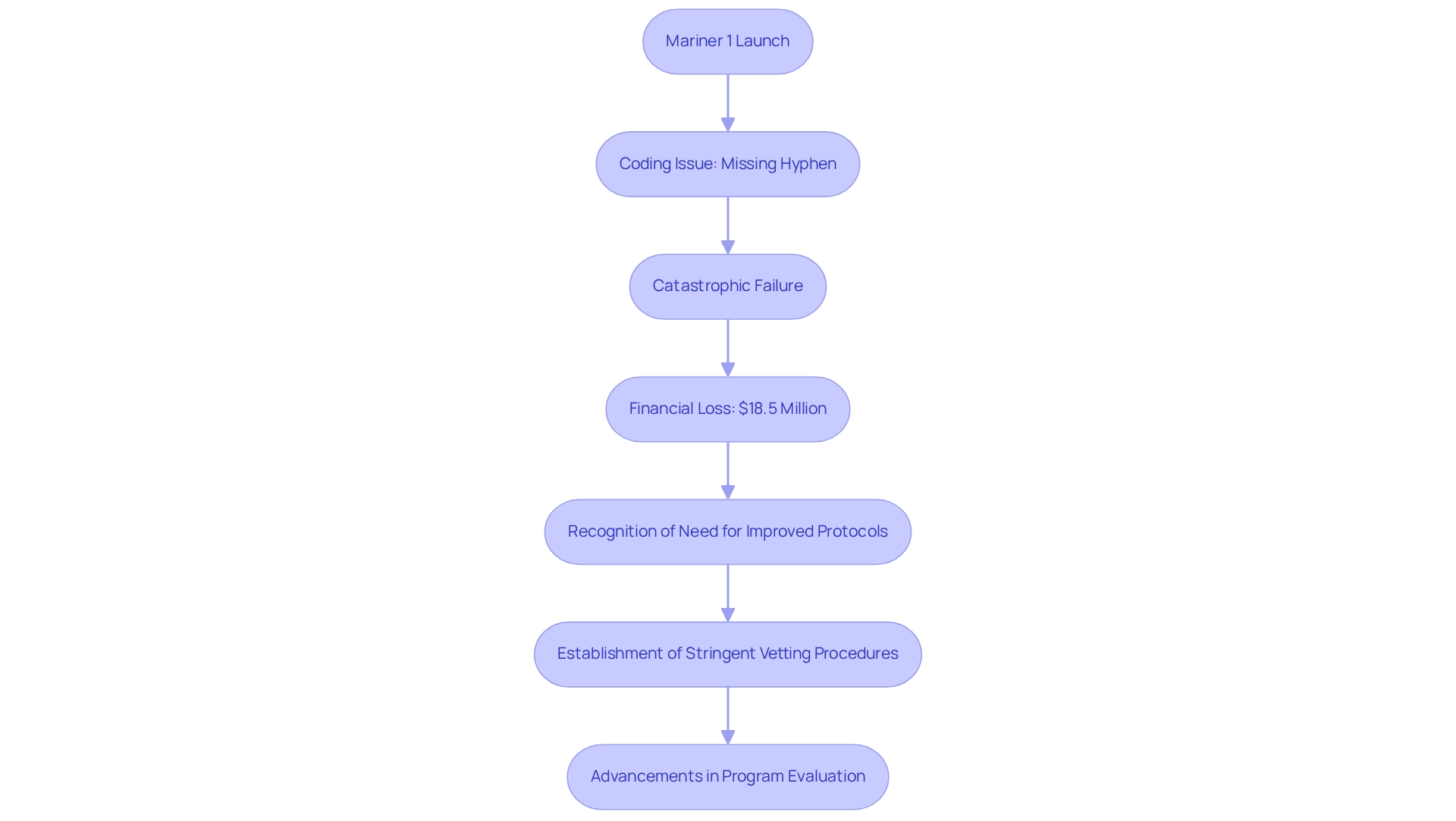
Pentium FDIV Bug (1994): A Costly Error That Impacted Intel's Reputation
In 1994, Intel faced a significant crisis when a bug in its Pentium processors' floating-point division algorithm was uncovered. This flaw resulted in incorrect calculations under specific conditions, leading to the recall of millions of chips at an estimated cost of $475 million. The event not only harmed Intel's reputation but also underscored the importance of thorough examination and validation procedures in hardware development, as seen in various software failure examples. Experts emphasize that identifying and resolving defects early in the evaluation phase decreases the chances of expensive corrections after deployment. Furthermore, the fallout from the Pentium FDIV bug highlighted the necessity of transparent communication with customers regarding product issues, as it significantly eroded consumer trust in the brand.
The iterative nature of prototype validation, which includes ongoing evaluation and refinement, serves as a practical illustration of effective assessment methods that could prevent problems similar to those observed in the Pentium FDIV incident. Today, the repercussions of this incident persist, serving as a warning for the tech industry about the essential importance of comprehensive evaluation and validation in hardware development, particularly highlighted by various software failure examples. As G. Suma noted, validation testing in big data systems is crucial to ensure the accuracy and reliability of massive datasets and their processing frameworks, illustrating the broader implications of rigorous testing beyond just hardware. Recent discussions in the industry further emphasize the ongoing relevance of the lessons learned from the Pentium FDIV bug.
Bitcoin Hack at Mt. Gox (2011): The Software Failure That Shook Cryptocurrency
In 2011, Mt. Gox, the largest Bitcoin exchange at the time, experienced a catastrophic hack that resulted in the theft of 25,000 Bitcoins, valued at approximately $400,000. This incident is significant as, at its peak, Mt. Gox managed 70% to 80% of Bitcoin trading volume, making the effects of its collapse particularly impactful on the cryptocurrency market. This breach not only highlighted serious security weaknesses within the exchange's systems but also revealed the wider dangers present in cryptocurrency platforms lacking robust security protocols.
The fallout from this incident prompted the cryptocurrency community to acknowledge the pressing need for enhanced security measures to safeguard user assets. As John J. Ray III, the current CEO of FTX, noted, "The operation of Alameda really depended, at least on the way it was operated, on the use of customer funds," emphasizing the critical importance of trust and security in the industry.
As a direct consequence of the Mt. Gox hack, the industry witnessed a significant shift towards the development of more secure exchanges and the implementation of improved risk management strategies. This pivotal event served as a crucial wake-up call, leading to a more vigilant approach to security in the cryptocurrency sector.
Furthermore, in light of recent developments, analysts predict that Bitcoin's price could drop towards $55,000 amid the Mt. Gox payout in July, underscoring the ongoing relevance of this incident in today's market. The case study titled 'Proactive Steps for Regaining Trust in Crypto' highlights the necessity for improved governance and cybersecurity following such incidents, aiming to restore public confidence and establish a safer environment for crypto investors.
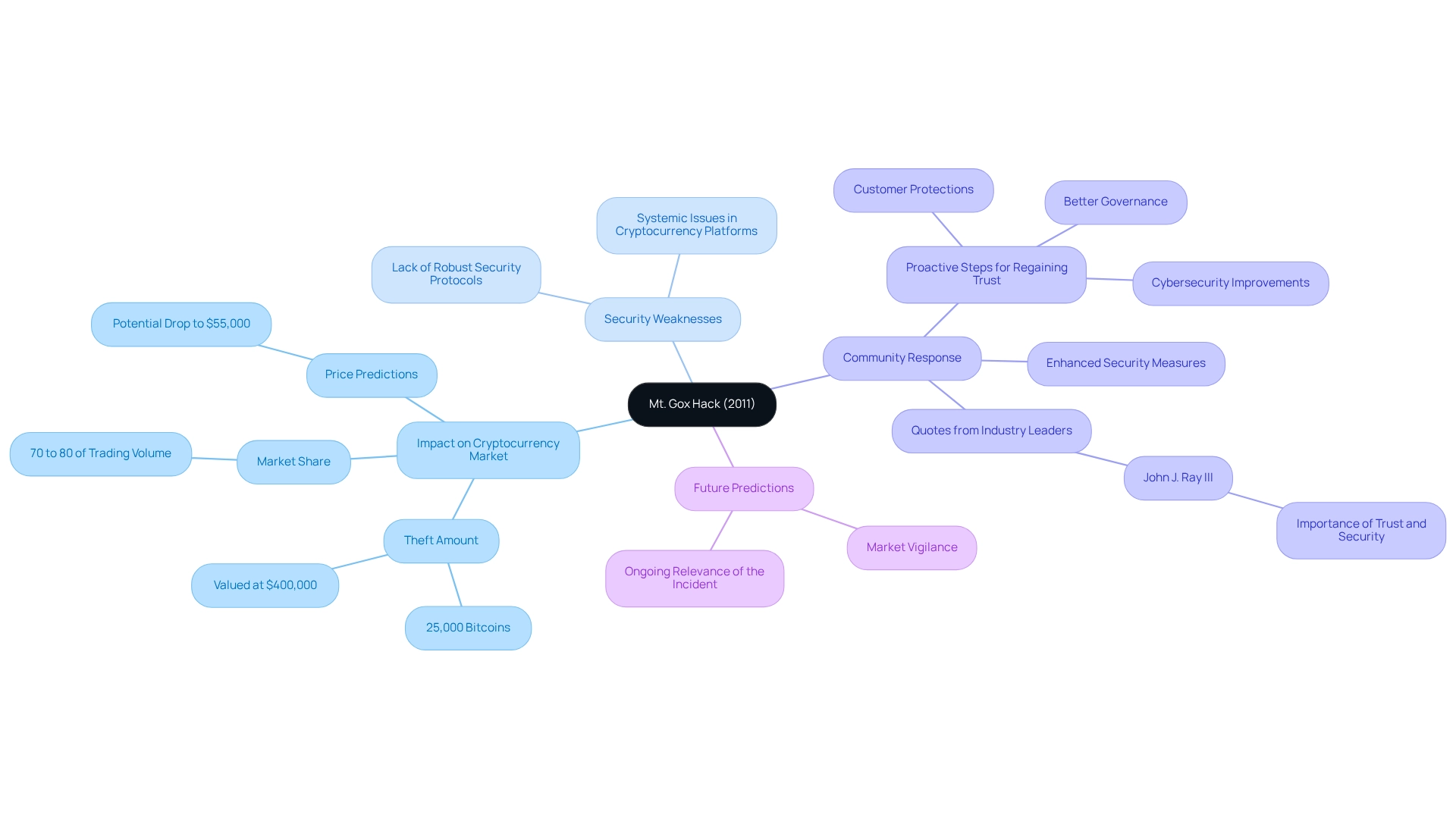
Heathrow Terminal 5 Opening (2008): Software Failures That Grounded Operations
The grand inauguration of Heathrow Terminal 5 in 2008 encountered significant challenges as it provided notable software failure examples, particularly within the automated baggage handling system, which was designed to manage 12,000 bags per hour. Instead, it encountered severe glitches, which are notable software failure examples, that led to widespread flight cancellations and delays. Furthermore, the situation was exacerbated by insufficient staff training, leaving employees ill-equipped to manage the new systems effectively.
This event underscored the pressing need for comprehensive evaluation, clear communication, and staff familiarization before implementing intricate systems in high-stakes environments. The lessons learned from this incident have since reshaped airport protocols regarding technology integration and staff training, emphasizing that well-prepared personnel are essential for operational success.
As Zaheer Minhas noted, "London Heathrow Airport underwent a major expansion with the completion of Terminal 5 in 2008," highlighting the scale of this undertaking. For instance, British Airways' phased approach to transferring long-haul flights to Terminal 5 post-opening illustrated the effectiveness of systematic adjustments, resulting in improved check-in times and baggage handling by October 2008.
This case exemplifies how addressing operational challenges through enhanced training, testing, and communication can significantly mitigate the impact of software failure examples. Moreover, the characteristics of high reliability organizations (HROs) serve as a contrasting framework, emphasizing the importance of reliability and preparedness in preventing such operational issues.
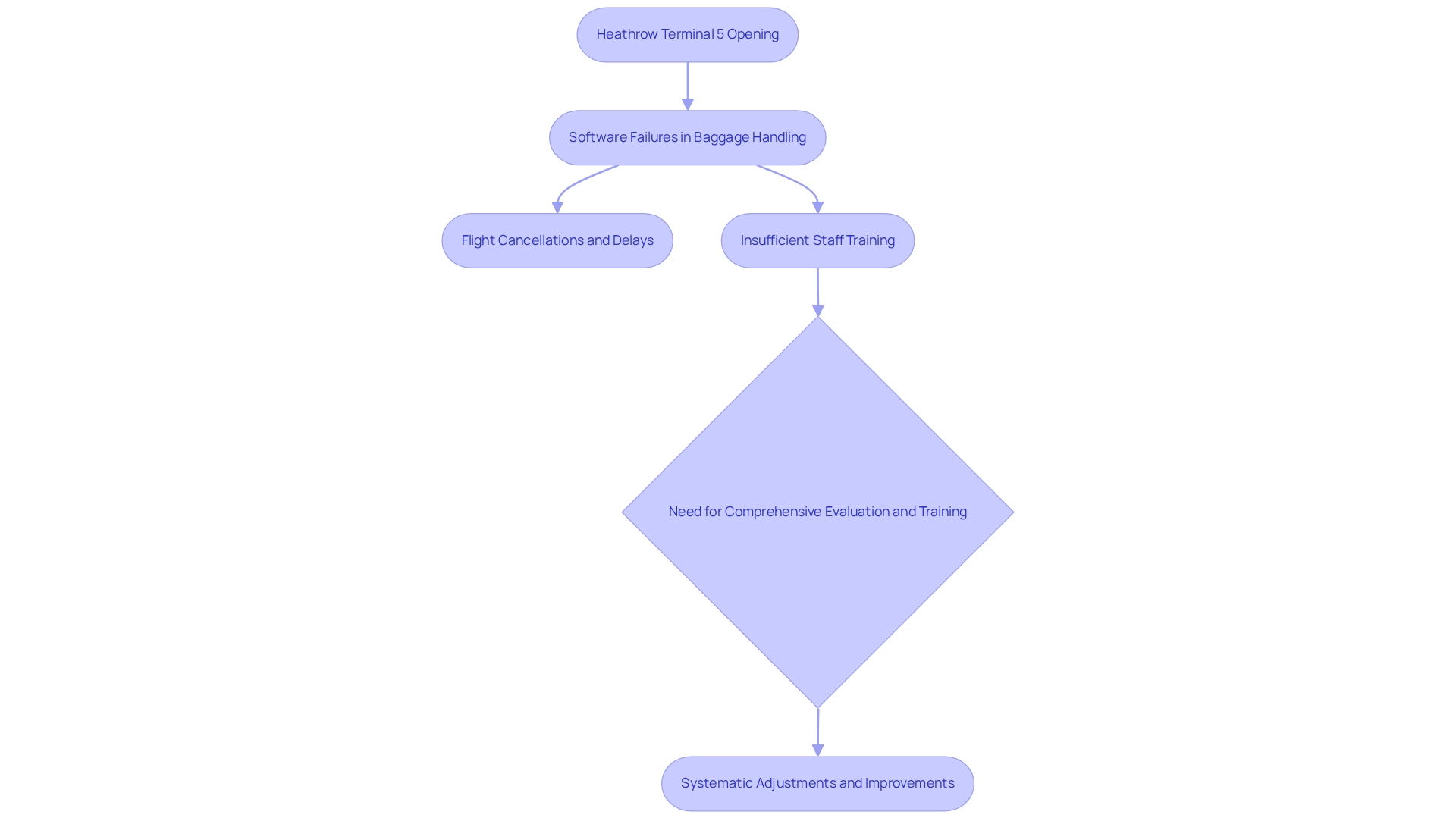
NASA's Mars Climate Orbiter (1998): A Software Error That Cost Millions
Coding challenges can be daunting for developers, especially when it comes to maintaining consistency in unit measurements. NASA's Mars Climate Orbiter incident serves as a stark reminder of the costly consequences of software failure examples, which amounted to approximately $327 million. This highlights the critical need for effective tools that can help prevent similar mistakes in the future.
Enter Kodezi, an AI-driven programming resource designed to tackle these challenges head-on. Kodezi automatically assesses bugs and fixes code, supporting over 30 programming languages. With both free and paid plans available, it caters to programmers at all levels, making it an accessible solution for enhancing coding practices.
By utilizing Kodezi, developers can significantly improve their productivity and code quality. Imagine spending less time on debugging and more on innovative solutions. The benefits extend beyond individual projects; they contribute to overall project dependability and success.
Why not explore the tools available on Kodezi's platform? With a focus on clear communication and thorough validation processes, Kodezi empowers developers to maintain unit consistency, ultimately avoiding expensive mistakes. As experts emphasize, "Again, be careful when dealing with decimal values." A more extensive report on software failure examples is set for publication in April 2025, promising to shed further light on the importance of accurate unit measurements in application development. Don't let inaccuracies hinder your progress—embrace the tools that can help you succeed.
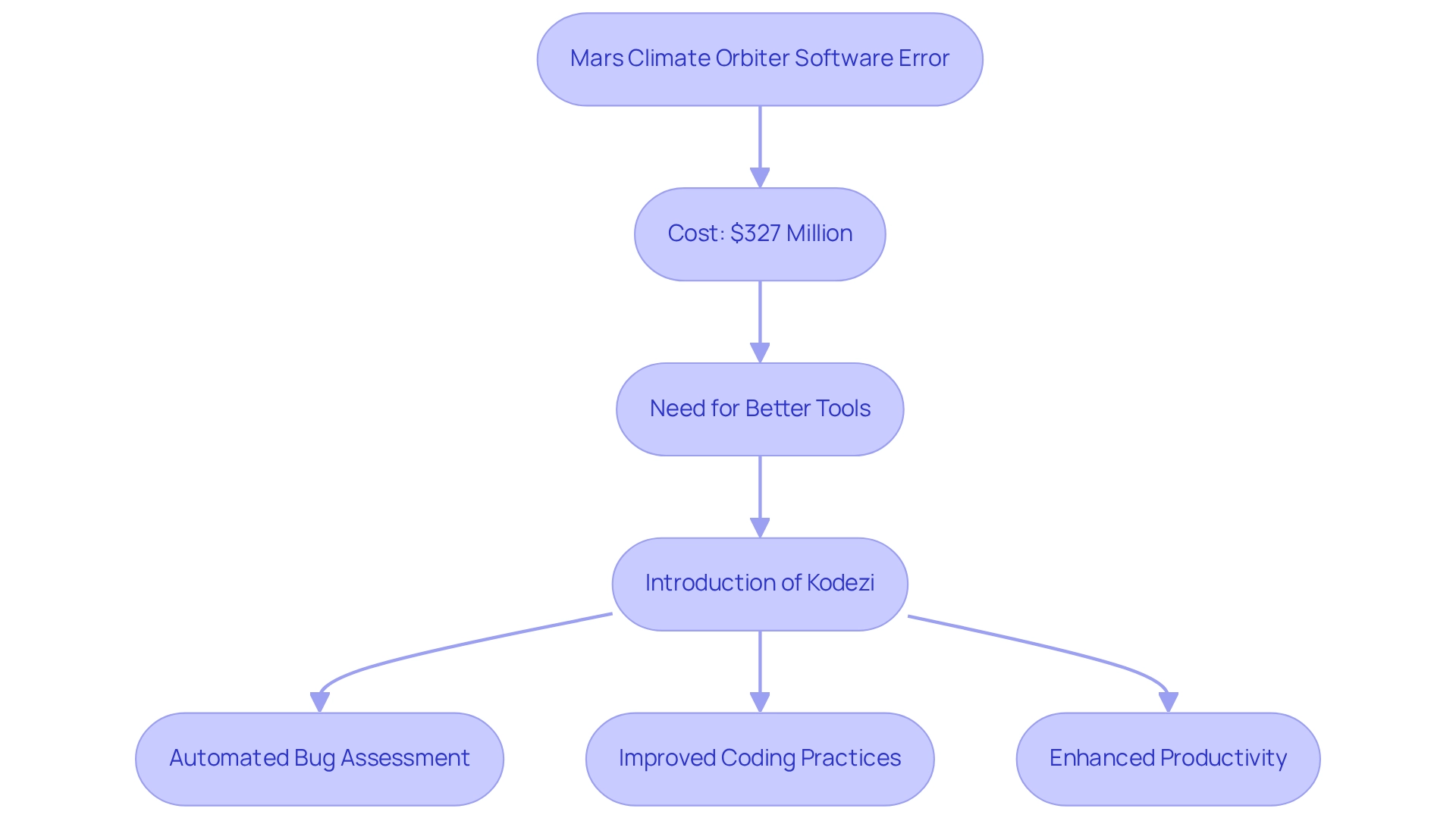
Soviet Gas Pipeline Explosion (1982): The Dangers of Software Errors in Industry
In 1982, a disastrous program malfunction caused the largest non-nuclear explosion in history at a Soviet gas pipeline. This incident serves as a stark reminder of the coding challenges developers face, particularly regarding the serious dangers linked to software failure examples in essential infrastructure. Reportedly, the CIA had implanted a logic bomb in the program controlling the pipeline, leading to a catastrophic failure upon activation. The explosion not only resulted in considerable financial losses but also heightened awareness regarding software failure examples and the vulnerabilities inherent in industrial systems.
Experts stress that rigorous testing is essential to safeguard against vulnerabilities highlighted by software failure examples, especially in high-stakes environments where safety is non-negotiable. The financial consequences of program faults are further highlighted by the estimated $100 billion allocated in the USA for contingency planning regarding the Millennium Bug in 2000. When details of the bug hit the international press, millions of people requested a new chip, costing Intel upwards of $475 million. This case study on the Millennium Bug illustrates the extensive measures taken to mitigate potential software failure examples arising from program vulnerabilities.
Furthermore, the consequences of system errors, such as software failure examples in critical infrastructure, can be dire, underscoring the need for comprehensive safety protocols and continuous monitoring to prevent similar disasters in the future. Recent news continues to emphasize the significance of addressing system vulnerabilities, showcasing various software failure examples that reinforce the essential need for thorough evaluation in industrial applications. Are we doing enough to protect our systems? The importance of rigorous evaluation and validation protocols cannot be overstated.
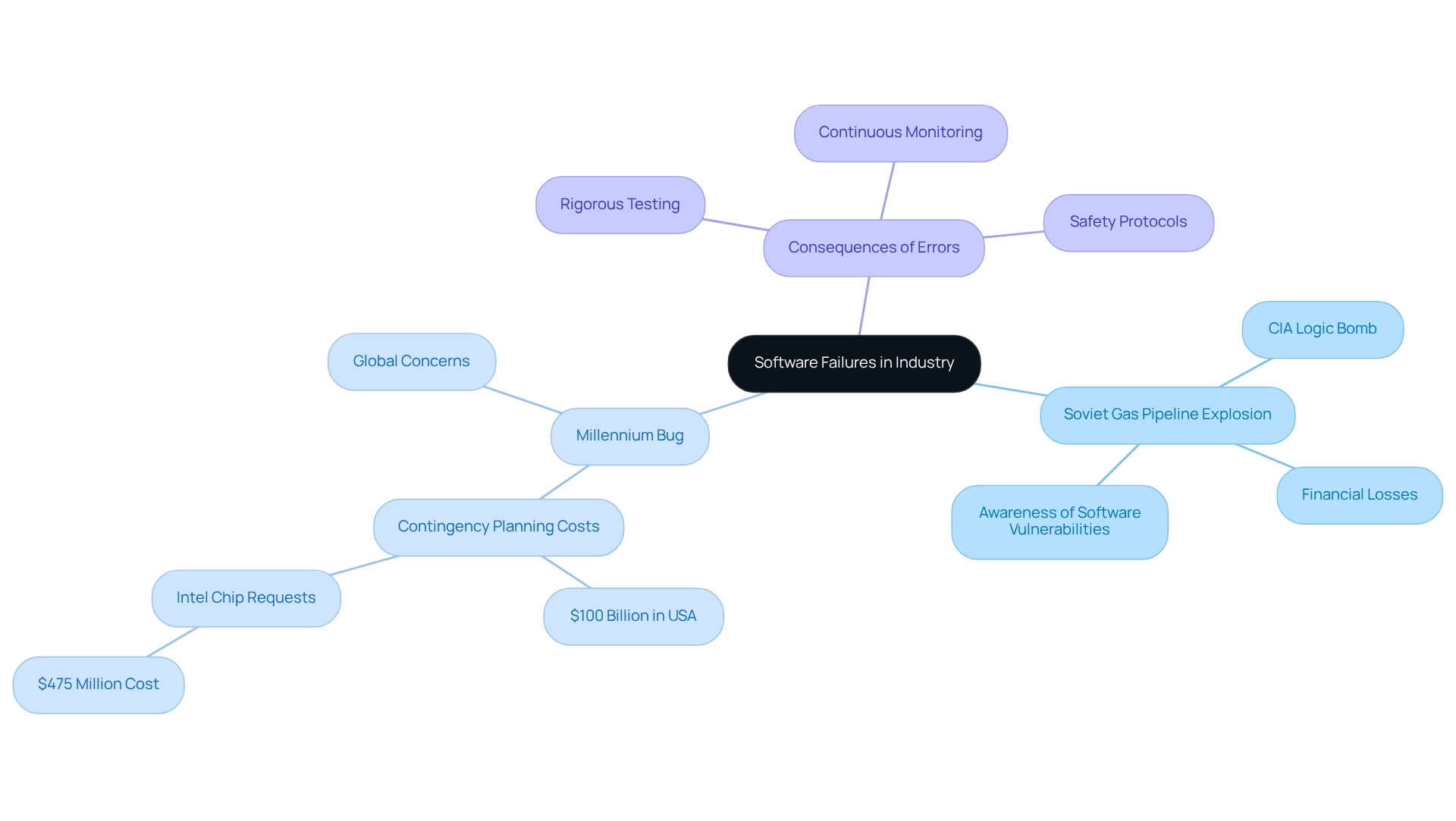
The Millennium Bug (2000): A Global Software Failure That Sparked Fear
Coding challenges are a common hurdle for developers, often leading to frustration and inefficiency. The Millennium Bug, or Y2K, serves as a historical example of software failure examples that illustrate how critical it is to address potential flaws in computer systems. As the year 2000 approached, there were widespread fears that the way dates were formatted would cause systems to fail. Organizations worldwide invested billions to rectify these issues, fearing malfunctions in critical systems. Although the actual impact of the Y2K crisis was minimal, it underscored the importance of proactive measures in program development and the necessity for thorough testing and validation, as seen in various software failure examples.
Unlike other solutions like Copilot, which primarily focus on code completion, Kodezi acts as an autocorrect for code. It automatically debugs and resolves coding issues, significantly enhancing productivity. Currently, Kodezi supports over 30 programming languages and integrates seamlessly with Visual Studio Code, with plans to expand compatibility to more IDEs in the future.
What benefits can Kodezi bring to your coding practices? By using Kodezi, developers can improve code quality and streamline their workflow, allowing them to focus on more complex tasks. The lessons learned from the Y2K incident have shaped how organizations approach updates and maintenance, highlighting the importance of incorporating advanced tools like Kodezi to avoid system breakdowns.
Are you ready to enhance your coding experience? Explore the tools available on the Kodezi platform and see how they can help you tackle coding challenges effectively.
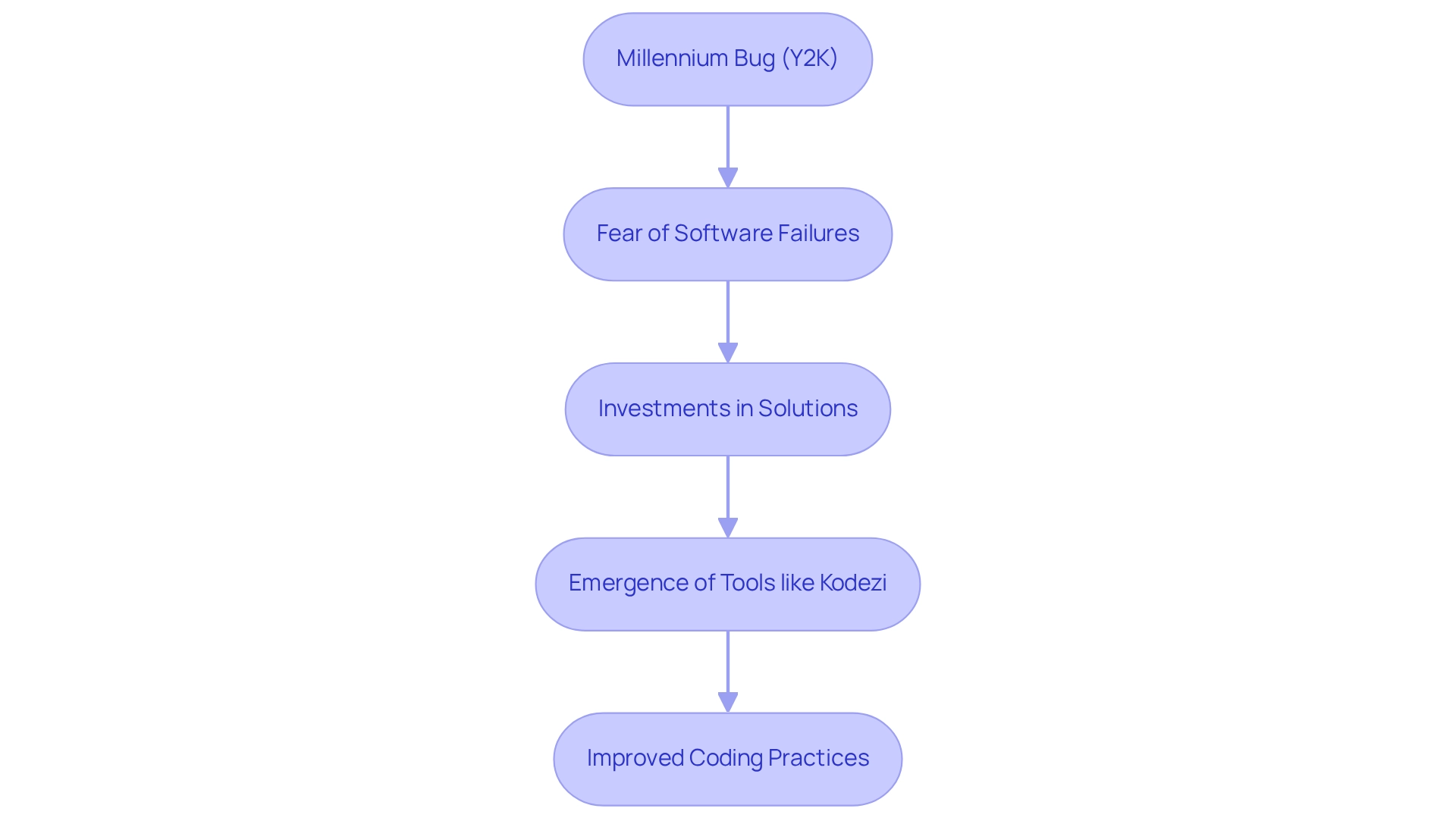
Knight Capital Group Trading Error (2012): A Software Failure with $440 Million Consequences
In 2012, Knight Capital Group faced a catastrophic trading error due to a technical malfunction, resulting in an astonishing loss of $440 million within just 45 minutes. This incident was triggered by a faulty deployment of a trading algorithm, leading to erratic stock purchases and significant market disruption.
The aftermath of this failure not only revealed immediate financial consequences but also highlighted the critical necessity for rigorous testing and comprehensive risk management in application development, particularly in high-frequency trading environments. Furthermore, the industry began a thorough reassessment of trading practices and system deployment strategies, underscoring the importance of strong oversight and quality assurance measures to avert similar incidents in the future.
Notably, GETCO invested $37 million in technology upgrades to sustain speed in high-frequency trading, illustrating the financial implications of ensuring system robustness. As financial analyst Jeff Sekinger pointed out, "Maximum drawdown accounts for the highest unrealized loss experienced by a trading strategy or portfolio, highlighting the peak risk exposure over a specified period."
This case serves as a stark reminder of the potential repercussions of software errors, illustrating the importance of learning from software failure examples and the paramount importance of effective risk management in high-frequency trading software. In addition, ongoing discussions about the future of high-frequency trading indicate that the industry may encounter significant regulatory scrutiny moving forward, reinforcing the need for advanced risk management practices, including the adaptation of machine learning algorithms for accurate risk assessments.
Conclusion
The exploration of notable software failures throughout history reveals critical lessons essential for the advancement of technology and development practices. From the Morris Worm that highlighted the imperative of cybersecurity to the catastrophic loss of NASA's Mars Climate Orbiter due to a simple unit conversion error, each incident serves as a stark reminder of the profound impact that software errors can have on both financial and operational levels. The failures at Mt. Gox and Heathrow Terminal 5 further underscore the necessity of rigorous testing and comprehensive training to ensure that systems function as intended, particularly in high-stakes environments.
In light of these historical lessons, the emergence of tools like Kodezi represents a pivotal step towards preventing future software failures. By automating code analysis and debugging processes, Kodezi empowers developers to enhance code quality and efficiency, thus mitigating the risks associated with human error. Furthermore, the proactive measures facilitated by such tools not only streamline the development process but also foster a culture of vigilance and accountability among developers.
Ultimately, the integration of advanced technologies in software development is not merely about improving productivity; it is about safeguarding the reliability and security of the systems that underpin our modern world. By learning from past mistakes and embracing innovative solutions, the industry can pave the way for a more secure and efficient technological future. The journey towards excellence in software development continues, and the lessons learned from history must remain at the forefront of this endeavor.
Frequently Asked Questions
What is Kodezi and what does it offer to developers?
Kodezi is an AI-driven programming tool designed to enhance code quality by automating the creation of API specifications, providing automatic code correction, and performing bug analysis. It supports over 30 programming languages and offers both free and paid plans.
How does Kodezi improve code quality?
Kodezi improves code quality by delivering thorough documentation, standardizing code, automating debugging and optimization, and allowing developers to generate code with a single click. This helps reduce mistakes and enhances clarity and consistency across projects.
What role does debugging play in software development according to Kodezi?
Debugging is critical in software development as it helps developers identify and resolve issues in their code. Kodezi emphasizes the importance of effective debugging, enabling developers to understand the actual behavior of their programs versus their intended behavior.
How does Kodezi align with Lean Software Development principles?
Kodezi aligns with Lean Software Development principles by focusing on building the right product while minimizing unnecessary code. This approach helps streamline development processes and enhances overall efficiency.
What are some significant software failure examples mentioned in the article?
Significant software failure examples include the Morris Worm incident, which caused widespread disruptions and highlighted the need for improved security protocols, and the Mariner 1 spacecraft failure, which resulted from a minor coding issue that led to a loss of $18.5 million.
What lessons can be learned from the Morris Worm incident?
The Morris Worm incident teaches the importance of verifying access to networks and emphasizes the need for improved security measures and thorough testing in application development.
How does Kodezi address the challenges of coding errors?
Kodezi addresses coding errors by automatically analyzing bugs, correcting code, and optimizing programming efforts, which helps developers avoid costly mistakes similar to those seen in past software failures.
What measures does Kodezi take to ensure user privacy?
Kodezi ensures user privacy by processing all code and data securely within the user's browser, thereby enhancing the reliability of the development tool.




